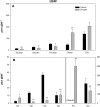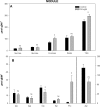Plant physiology and proteomics reveals the leaf response to drought in alfalfa (Medicago sativa L.)
- PMID: 20797998
- PMCID: PMC2993905
- DOI: 10.1093/jxb/erq249
Plant physiology and proteomics reveals the leaf response to drought in alfalfa (Medicago sativa L.)
Abstract
Despite its relevance, protein regulation, metabolic adjustment, and the physiological status of plants under drought is not well understood in relation to the role of nitrogen fixation in nodules. In this study, nodulated alfalfa plants were exposed to drought conditions. The study determined the physiological, metabolic, and proteomic processes involved in photosynthetic inhibition in relation to the decrease in nitrogenase (N(ase)) activity. The deleterious effect of drought on alfalfa performance was targeted towards photosynthesis and N(ase) activity. At the leaf level, photosynthetic inhibition was mainly caused by the inhibition of Rubisco. The proteomic profile and physiological measurements revealed that the reduced carboxylation capacity of droughted plants was related to limitations in Rubisco protein content, activation state, and RuBP regeneration. Drought also decreased amino acid content such as asparagine, and glutamic acid, and Rubisco protein content indicating that N availability limitations were caused by N(ase) activity inhibition. In this context, drought induced the decrease in Rubisco binding protein content at the leaf level and proteases were up-regulated so as to degrade Rubisco protein. This degradation enabled the reallocation of the Rubisco-derived N to the synthesis of amino acids with osmoregulant capacity. Rubisco degradation under drought conditions was induced so as to remobilize Rubisco-derived N to compensate for the decrease in N associated with N(ase) inhibition. Metabolic analyses showed that droughted plants increased amino acid (proline, a major compound involved in osmotic regulation) and soluble sugar (D-pinitol) levels to contribute towards the decrease in osmotic potential (Ψ(s)). At the nodule level, drought had an inhibitory effect on N(ase) activity. This decrease in N(ase) activity was not induced by substrate shortage, as reflected by an increase in total soluble sugars (TSS) in the nodules. Proline accumulation in the nodule could also be associated with an osmoregulatory response to drought and might function as a protective agent against ROS. In droughted nodules, the decrease in N(2) fixation was caused by an increase in oxygen resistance that was induced in the nodule. This was a mechanism to avoid oxidative damage associated with reduced respiration activity and the consequent increase in oxygen content. This study highlighted that even though drought had a direct effect on leaves, the deleterious effects of drought on nodules also conditioned leaf responsiveness.
Figures



References
-
- Aguirreolea J, Sánchez-Díaz M. CO2 evolution by nodulated roots in Medicago sativa L. under water stress. Journal of Plant Physiology. 1989;134:598–602.
-
- Allen DJ, McKee IF, Farage PK, Baker NR. Analysis of the limitation to CO2 assimilation on exposure of leaves of two Brassica napus cultivars to UV-B. Plant, Cell and Environment. 1997;20:633–640.
-
- Alley R, Berntsen T, Bindoff NL, et al. Climate change 2007. The physical science basis. In: Solomon S, Qin D, Manning M, Chen Z, Marquis M, Averyt KB, Tignor M, Miller HL, editors. Contribution of Working Group I to the Fourth Annual Assessment Report of the Intergovernmental Panel on Climate Change. Cambridge: Cambridge University Press; 2007.
-
- Andrews JR, Bredenkamp GJ, Baker NR. Evaluation of the role of state transitions in determining the efficiency of light utilization for CO2 assimilation in leaves. Photosynthesis Research. 1993;38:15–26. - PubMed
-
- Antolín MC, Sánchez-Díaz M. Photosynthetic nutrient use efficiency, nodule activity and solute accumulation in drought stressed alfalfa plants. Photosynthetica. 1992;27:595–604.

